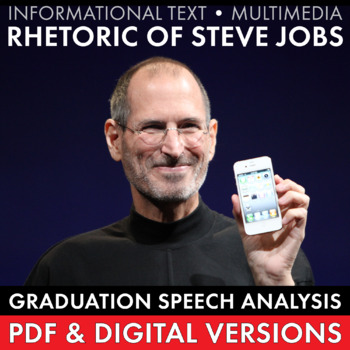Steve Jobs & Real World Rhetoric Analysis, Grad Speech, PDF & Google Drive CCSS
- Zip
- Google Apps™

What educators are saying
Description
Show your students a real-world application of the tools of rhetoric (ethos, pathos, and logos) as they examine the 2005 Stanford University Commencement Address given by Apple Co-Founder Steve Jobs. The speech, which is filled with warmth, humor, and meaning, is a high-interest way to add the non-fiction analysis skills emphasized by the Common Core to your classroom.
Students will learn the components of Aristotle’s rhetorical devices, view Jobs’ speech via a 14-minute video clip, and use a full-text transcript of his words to answer/discuss depth-of-knowledge questions. (Links for media included.) The worksheet questions require students to dig deep into the text as they support their answers about Jobs’ message and his skillful use of ethos, pathos, and logos. Finally, students will make personal connections to the issues raised by Jobs, which always make for compelling class discussions.
The materials, which will take a full hour to work through, include:
• Detailed lesson directions with helpful tips
• Two-slides (in Powerpoint, Google Slides, and SMARTBoard’s Notebook software format) to use as a mini-lesson about Aristotle’s tools of rhetoric
• A 5-minute video of lecturer notes to use as prep for the slide presentation (link included)
• A transcript of the speech (link included)
• A 14-minute video of Jobs’ speech (link included)
• A short answer set of questions that will help students identify and analyze the elements of the speech
• An answer key to make for easy grading and to help guide class discussion
This material (a total of two slides, four pages of PDF content + Google Slides version of the student handout, and multimedia links) is appropriate for sixth through 12th grade students.
Want students to learn more about Steve Jobs? Click here for a student-driven biography research activity:
Want more activities like this one? Click here to scroll through my entire collection of video-based lessons: https://www.teacherspayteachers.com/Store/Laura-Randazzo/Category/Video-Based-Lessons-496064
NOTE: This item is included in my English 9-10 full-year curriculum. If you already own the full-year download, please do not purchase this item here individually. If you’d like to receive this item plus everything else needed to teach 180 days of English 9 or English 10 at a deeply discounted price, click here to learn more about the full-year curriculum download.
Thanks for stopping by!
Cover image credit: Matthew Yohe, WikiMedia Commons, CC BY-SA 3.0





